






































Publisher Tracy Patterson, BSc, MES
Design & Production Vegetorium, LLC
Copy Editor Sara Gurgen, MS
Digital Platforms
Carolyn Coogan Locable
Natural Awakenings – Phoenix Tracy@NaturalAZ.com NaturalAZ.com
CEO Kimberly B. Whittle
COO Michael Bevilacqua
CMO Vee Banionis
Sr. VP Operations Brian Stenzler, DC
National Editor Sandra Yeyati
Editor Brooke Goode
Copy Editor Melanie Rankin
Print Production Specialist Kevin Rankin
Design Director Agnes Mazeikaite Production Flip180
Executive Admin Julius Frago
Cover image
AdobeStock_31577056
© 2025 by Natural Awakenings. All rights reserved. Although some parts of this publication may be reproduced and reprinted, we require that prior permission be obtained in writing. Natural Awakenings is a free publication distributed locally and is supported by our advertisers. Please call to find a location near you or if you would like copies placed at your business. We do not necessarily endorse the views expressed in the articles and advertisements, nor are we responsible for the products and services advertised. Check with a healthcare professional regarding the appropriate use of any treatment.
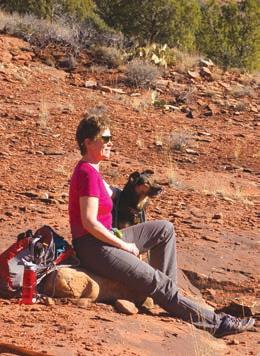
This month’s Green Living article on page 26 reminded me of the wild berries we were fortunate to have in two places we lived.
The first was on our horse ranch, where the mighty wild strawberries abounded along our very long driveway. They were tiny but packed with flavor, and every time I ate some, I thought, “Ah yes, now I remember what a strawberry is supposed to taste like!”
I wasn’t the only one enjoying these tasty morsels. Our wonderful Rottweilers, Jesse and Shiloh, started to notice that we were bending over, picking something, and eating it. This prompted them to check out the promising snack. Loving most food, they began going ahead of us, nipping off strawberries and applying a little slobber to others—which, of course, put a crimp in our strawberry-eating activities. Soon, it became a race to see who could get to the new berries first.
The second place was our home near the ocean, where tons of wild blackberries could be found along the roads and paths in the area. Here, you could harvest buckets of these delectable berries for any number of purposes—pies and jam come to mind. Or just stuff your face and hope to avoid a stomachache from the gluttonous fun. There were only a couple of provisos: one, you had to fight the prickly branches to get at some of the berries, especially when they were picked over by other people—and bears; and two, you wanted to stay away from the lower branches… you know, within dog-peeing height.
A note about the bears. There were so many, it wasn’t “if” you saw a bear—it was “when.” However, there was such an abundance of food between the berries and the salmon (among other edibles), that the bears pretty much kept to themselves and weren’t a problem. I remember one time walking along a path and seeing bear scat—pure salmon, with some berries mixed in!
It’s a wonderful feeling to have these bountiful wild food sources in such abundance—and I’m sure our dogs and the bears thought so too!








Genetic inheritance plays a crucial role in transmitting health-related information from parents to offspring. While lifestyle and environmental factors are known to impact sperm quality and influence the biological information passed on, the underlying mechanisms remain unclear. Animal studies have suggested that small, non-coding ribonucleic acid (sncRNA) regulates the activation and deactivation of genes in the sperm genetic material.
A study published in the journal Nature investigated the effects of a short-term dietary change on sperm quality. Eight men were provided with olive oil, vitamin D and omega-3 fatty acids as part of their diet for six weeks, while a control group of nine men maintained their standard diets. The researchers observed that the dietary intervention altered multiple sncRNA signals carried by the sperm, particularly those related to fatty acid metabolism and gene expression. These findings contribute to the growing evidence suggesting that paternal health and nutrition during conception may play a role in the developing embryo and possibly the long-term health of the child.

While the Pap smear helps diagnose more than 13,000 cases of cervical cancer annually in the United States, nearly a quarter of American women are lagging behind in their screening regimen due to various factors, including discomfort, pain, invasiveness or even traumatic experiences associated with the procedure. Recently, Teal Health, Inc. received approval from the U.S. Food and Drug Administration for an alternative cervical cancer screening device that can be used at home.
The Teal Wand enables individuals to self-collect vaginal samples using a swab, which is subsequently mailed to a laboratory for testing purposes, where it is analyzed to detect the human papillomavirus (HPV), the virus that causes nearly all cervical cancers. A clinical study demonstrated that the Teal Wand was as effective as a Pap smear in detecting early-stage cervical precancers. Among the study participants, 94 percent preferred the self-collection method over the Pap smear, and 86 percent expressed a willingness to maintain regular screening if provided with this alternative option.
According to a paper published in the Journal of Medical Entomology, scientists found ticks carrying babesiosis disease in several Mid-Atlantic states. The rare, parasitic infection lives in the blood of rodents such as shrews, chipmunks and mice, and can be contracted by humans through tick bites. According to the U.S. Centers for Disease Control and Prevention, babesiosis can attack red blood cells and cause flu-like symptoms, including fever, chills, body aches, nausea and fatigue.
Historically, the disease has been reported in the Upper Midwest and Northeast regions of the United States. In this study, researchers collected more than 1,300 black-legged ticks from Virginia, Maryland and Delaware and discovered that 2.7 percent of the ticks carried the babesiosis parasite. Although the incidence rate is relatively low, these findings underscore the importance of healthcare providers in these states to be vigilant for the disease and provide appropriate treatment to affected individuals.


According to a report from the American Lung Association (ALA), approximately 156 million Americans, or 46 percent of the population, lived in areas with unhealthy air quality from 2021 to 2023, the period of analysis in the most recent report. This represents a higher number of individuals than at any time in the preceding decade. Bakersfield-Delano, California, was the region most affected by pollution.
The report suggests that the United States is experiencing a decline in clean air measures. Record-breaking heat, drought and wildfire smoke caused by climate change are damaging air quality throughout the country. The ALA’s analysis is based on official air quality monitoring sites maintained by federal, state and tribal governments.
An unrelated 2023 report from Stanford University, published in the journal Nature, estimated that wildfire smoke has undone about a quarter of the progress achieved under the Clean Air Act of 1963.

The waters off the coast of the Philippines harbor a tiny sea slug known as the leaf sheep. Measuring only seven to eight millimeters in length, this remarkable marine invertebrate has black eyes, insectlike antennae with black tips that resemble sheep’s ears and spiky green appendages distributed across its body known as the cerata.
The leaf sheep feeds on Avrainvillea, a species of algae. After ingesting the algae’s cells containing chlorophyll, the slug stores it in the tissues of its cerata for up to 10 days. This allows the slug to supplement its algae-based diet with photosynthesis, a process typically reserved for plants that converts sunlight into energy.
It is estimated that the human eye can see almost 10 million different colors. In a paper published in Science Advances, scientists described a precise laser setup that stimulated the retinas of five participants, three of which were co-authors of the paper, to perceive colors beyond the normal human visual range.
The procedure, called “Oz”, involved delivering minute doses of light to the cone cells in the eye responsible for detecting the color green. Each participant observed a saturated bluish-green color resembling teal, which the researchers named “olo”. The participants confirmed that olo was beyond the standard visual range by comparing it with a teal-colored laser and adjusting the saturation by subtracting white light.


Upcycling—the process of giving discarded or worn items new life—offers a sustainable alternative to wasteful consumption. By transforming ordinary objects into artistic creations, we can express our individuality and contribute to a more environmentally conscious society. The garden presents an ideal platform for upcycling because it allows us to repurpose obsolete items at low cost.
Whether we turn a rusty wheelbarrow into a flowerbed, salvage a thrift store teapot to use as a planter or rescue a well-worn table to become an outdoor potting station, our creativity can transform any outdoor space. Reviving haggard chairs and benches with vibrant colors or intricate designs elevates garden seating to new heights. Filling a retired bathtub or sink with plants, repurposing an unused clothing rack for hanging plants or turning a secondhand bookcase into a vertical garden are fun and surprising projects.
• For a touch of functional whimsy, fill chipped teacups with birdseed and hang them on tree branches.
• Paint and decorate discarded tires, then fill them with plants.
• Use shutters and doors as garden dividers.
• Lean an old wooden or metal ladder against a tree and place potted plants on the rungs, or use it as a trellis against a garden wall.
• Position an old bike to support climbing clematis, roses, ivy or morning glories.
• Use scraps of wood, bricks or pallets to create a rustic walkway.
• Turn metal or enamel colanders into hanging planters with built-in drainage.
• Use a weatherproofed baby carriage or
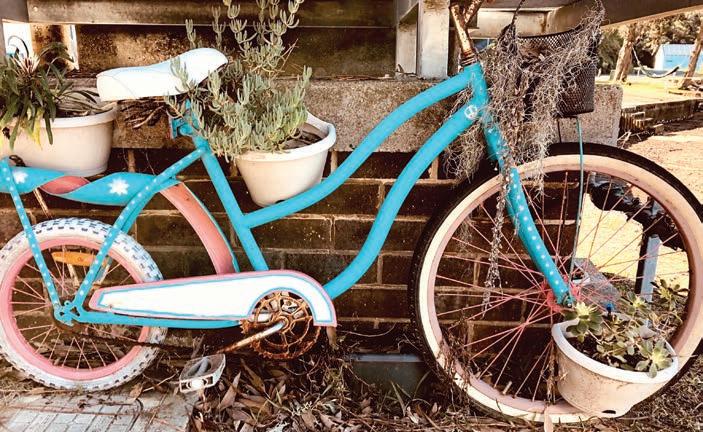
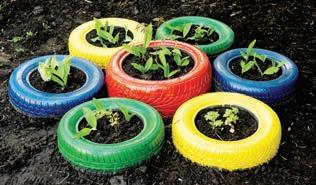
doll stroller to showcase potted flowers on a porch, under a tree or at the edge of a garden.
• Turn old stainless-steel cutlery or wooden kitchen utensils into wind chimes or mobiles.
• Place tea lights in empty jam jars to light garden paths.
• Nestle a plant in a broken terracotta pot for a rustic, bohemian vibe.
• Use buckets as hanging planters for herbs, ferns or flowers.
• Fill old rubber boots with soil to make quirky planters and place them around the mailbox or front door.
• Reinforce any loose parts to ensure that furniture, ladders and other objects can hold the weight of plants.
• Drill holes in items used as planters to provide proper drainage.
• Weatherproof wooden and wicker items with exterior latex paint, stain or sealants. Consider eco-friendly options such as versatile milk paint in earthy or vibrant hues. Remember to protect metal décor with an anti-rust coating or paint.
by Carrie Jackson
While many of us dream of epic journeys to faraway places, humbler excursions can also provide unforgettable memories and experiences. British adventurer and bestselling author Alastair Humphreys coined the term “microadventure” to describe a brief and inexpensive outdoor jaunt close to home. From a weekend getaway on a nearby hiking trail to an afternoon visit at a local park, microadventures offer flexible scheduling, budgetfriendly options, health benefits and a deeper connection to Mother Earth.
“I think that microadventures are popular right now because we are short on time, and money is tight for many people,” says
Humphreys, a National Geographic Adventurer of the Year. “We are ridiculously busy in our daily lives, but we are also craving the physical and mental respite of time in nature—fresh air, exercise and time away from our cursed phones. It’s great to have the adventure of a lifetime, but until that lucky opportunity comes around, why not try to have a lifetime filled with tiny little experiences squeezed around the margins of busy daily life?”
Humphreys has traveled the globe experiencing extraordinary adventures such as rowing across the Atlantic Ocean, walking the length of the holy Kaveri River in India

and traversing Iceland by foot and packraft. More recently, he dedicated a year to enjoying adventures in his own neighborhood, as recounted in his book Microadventures: Local Discoveries for Great Escapes
“I focused on the single, small local map centered around my home, covering about five miles in each direction from my front door,” explains Humphreys. “At first, I worried that this would be too small, too boring or too claustrophobic. But I realized that once I slowed down, paid attention and had an adventurous mindset every day, I started to discover new places close to home I’d never seen before—new streets, new parks, new patches of woodland, new places to run. I found fragments of wild places where I could sit with a cup of coffee, all within sight of the skyscrapers of the biggest city in my country.”
Humphreys encourages others to embark on a similar year of localized exploration, reminding them to establish realistic goals and remain open to novel experiences. He also suggests aligning activities with the seasons to harmoniously celebrate the natural order. Visit the same spot during each equinox and solstice, for example, to appreciate the way the landscape changes over the course of a year. A mountain view or shoreline feels and looks different in spring, summer, autumn and winter.
“Declare your intention and outline your plans,” Humphreys recommends. “Sleep outside one night. See a sunrise blaze across the
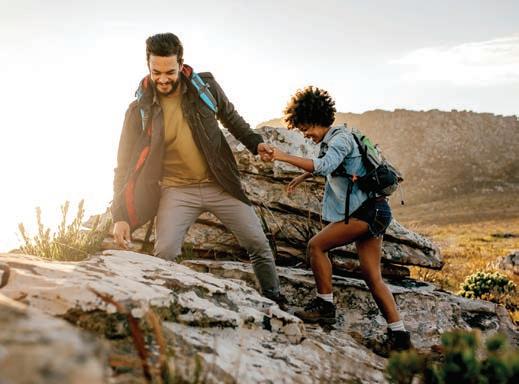
sky for a romantic Valentine’s Day. Celebrate blue moons and other celestial events.” Natural splendor is all around us.
Kameron Stanton is the chief operating officer and event manager for Black People Outside, a Chicago-based organization founded during the pandemic to encourage people of color to get outside and explore. A weekend trip with his partner, Chevon Linear, to the Grand Teton National Park during lockdown was a memorable experience. “Seeing the stars so clearly at night unlocked something in us,” Stanton recalls. “We regained a respect for Mother Nature and what the beauty of the outdoors could do for your psyche.”
A microadventure in nature presents Stanton with unique survival challenges. “In the city, everything is zooming past you so quickly. When you are outside in thoughts and have to fend for yourself in a different way,” he explains. “If you don’t build a fire, you’re going to be cold. If you don’t have the right equipment, you could get in trouble. There are little things the outdoors can teach you in a controlled manner. You learn lessons in planning and structuring your day, while still having fun and discov ering new things about yourself and the world you’re in.”
“Activities like hiking help build strength, endurance, respiratory health, weight loss and so many other physical elements,” Stanton asserts. “Most people you meet who regularly spend time outdoors tend not to be angry and upset. They’re looking at the things because they are literally around brighter things. Nature feeds you and helps you feel grounded with your thoughts and feelings.”
Microadventures can also be opportunities for social engagement. Stanton suggests joining a local club related to an interest such as fish ing, running or birdwatching. “Once you start having microadven tures, you’ll connect with like-minded people, and you never know where that may lead you,” he says.




There are myriad ways to enjoy a microadventure in almost any environment, including hiking, kayaking, biking, skiing, climbing, rollerblading and fishing. “Forest preserves and state and national parks offer incomparable views and trails year-round. They tend to have a low admission price, and most are accessible as long as you have a vehicle,” says Stanton, noting that a lazy afternoon fishing or tubing down a river may be just a short drive away.
Day hiking has become a popular pastime, in part because it combines many of the advantages of microadventures. “It offers a perfect opportunity to break away from the routine, explore nature and enjoy the mental and physical benefits of being outdoors," says Jacqueline Kehoe, a journalist and expert advisor for Recreational Equipment, Inc. (REI), which provides a wide range of equipment, apparel, workshops and other resources for adventure seekers. Similar gear retailers include Backcountry and Sierra Trading Post.
“Whether you’re planning a short stroll through a local park or a longer trek up a nearby mountain, you always want to be prepared,” Kehoe advises. “Packing the right gear will help you make the most of your time on the trail, whether you’re a seasoned hiker or just starting out.” For most microadventures, a small hiking pack should suffice for carrying the necessary gear.
What to bring depends on multiple factors, including trail conditions, weather, the hike’s difficulty and the duration, which can

range from a couple of hours to an entire day. Kehoe recommends bringing ample food and water to stay energized and hydrated, even on shorter hikes. A good starting point is one liter of water per person per hour, but this amount should be adjusted based on individual needs and the intensity of the hike. “Once your hike is longer than a few hours or goes into unfamiliar or backcountry terrain, the essential gear list grows,” Kehoe counsels.
Weather-appropriate clothing can make or break an adventure. “Dressing in moisture-wicking layers can help you stay comfortable. The weather may change quickly, so it’s important to be prepared for various conditions. Choose sturdy, comfortable shoes that provide

Sept. 6th Sept. 6th

by Marlaina Donato
Summer presents a timely invitation to sip from a full cup, set aside todo lists and sink our toes into all that shimmers. Somewhere between keeping the kids entertained and weeding the flower beds is an opportunity to tend to our abandoned joys. It can be as simple as noticing the tinkling of ice cubes in a glass or planning an enchanted picnic at sunset with colorful cloths draped beneath a tree.
Summer comes but once a year, and as our backyard blooms in vibrant hues, so should we. Buying new, sultry spices for the cupboard, scenting the bed sheets with stress-reducing ylang ylang essential oil, placing fresh flowers into a tea pot instead of
a traditional vase or walking barefoot after a storm tells the nervous system that there is more to life than the chores. Inspiration is an unpredictable muse; waiting for her to notice us in our busy lives is most often futile. Combating the monotony of routine in small, daily gestures is easy and lights up our senses.
Relinquishing the common tendency to feel self-conscious is key. “Be brave enough to live life creatively,” says actor Alan Alda. Such courage may require that we break our own rules. If you usually prefer venturing out with company, make a point of going out solo for a backroad drive with no destination and a good playlist. If you haven’t drawn since childhood, buy some colorful
pens and doodle in a sketchbook. Host a fancy herbal tea party and invite a neighbor you’ve never spent time with.
Wear a breezy scarf and flowers in your hair, even if you’re just running errands. Ask someone you’ve long admired to go out on a date and attend a local free concert under the stars. Everyone that is accustomed to seeing you living life a little more low-key will get over it. Having a wild love affair with summer is good for the soul and might even change your life.
Marlaina Donato is an author, painter and composer. Connect at WildflowersAndWoodSmoke.com.

by Megy Karydes
As summer’s longer days encourage outdoor activities, we face heightened exposure to solar radiation and other environmental irritants. Skin protection becomes a priority, and conventional options often employ synthetic ingredients that can irritate sensitive skin and cause adverse environmental effects. Natural alternatives offer a gentler and more sustainable approach to maintaining healthy and resilient skin all season long.
Summer protection extends beyond aesthetic and physiological considerations. According to the American Academy of Dermatology, individuals of all ages are susceptible to skin cancer, with about one in five Americans developing the condition during their lifetime. Because solar radiation can
cause burns, skin cancer and premature aging, avoiding the most intense rays between 10 a.m. and 2 p.m., seeking shade, applying sunscreen and wearing wide-brimmed hats and sun-protective clothing are some of the easiest safeguards.
During the summer months, the skin takes a beating from heat, sweat, sun exposure and frequent washing, so using products that both soothe and restore balance is important. Natural ingredients, including oatmeal, honey and lavender, offer gentle yet powerful options for protecting and soothing skin.
Oatmeal locks in moisture, eases inflammation and soothes irritation caused by sun

exposure or sweat, according to the Cleveland Clinic. When finely ground into what is known as colloidal oatmeal, its efficacy is amplified, forming a protective barrier that hydrates and calms sensitive skin. Its popularity in creams, lotions and sunburn treatments stems from inherent anti-inflammatory and moisturizing properties.
Honey serves as a natural humectant that draws moisture into the skin. Recent research published in Pharmaceuticals indicates that products with higher concentrations of the sweet nectar provide improved skin hydration and reduced wrinkle depth. Floral honey, rich in natural sugars, is more effective at boosting moisture than forest honey. Even with different variants or quantities, honey-infused products feel luxurious and gentle on the skin.
Rachel Sloan, a Chicago-based beekeeper and founder of Nature’s Trace Company, frequently incorporates ingredients from her garden and hives into small-batch, nature-inspired soaps designed for gentle cleansing and nourishment. She uses both raw honey and finely ground oatmeal in many of her soaps.
Renowned for its anti-inflammatory properties, lavender essential oil is another popular ingredient. When diluted in a carrier oil, it may be effective in soothing minor burns due to its pain relieving and antimicrobial qualities. Julie Williams, a medical herbalist and founder of Leaf People, based in the Colorado Rockies, is drawn to lavender essential oil’s healing properties. It is a key ingredient in some of her products that offer fast, natural relief from sun-exposed skin.
According to both Williams and Sloan, when it comes to summer skin care, most people focus on protection—sunscreen, hats and long sleeves—but what often gets overlooked is replenishment. Even with the best preventative measures, exposure to sunlight can leave the skin depleted and

vulnerable due to heat, ultraviolet rays and environmental stressors. It is essential to thoroughly rinse off not only sweat and sunscreen, but also the toxins released by the body through heat and exertion.
“Following that cleanse, replenishing the skin with antioxidant-rich ingredients like vitamin E, vitamin C, green tea, ginkgo biloba or gotu kola helps restore what’s been lost and supports cellular recovery,” says Williams. “For those in persistently hot climates, cooling botanicals like rose, burdock root, cucumber and chamomile can soothe mild irritation and bring down surface heat. Incorporating these into your evening routine allows your skin to rest, regenerate and recover while you sleep.”
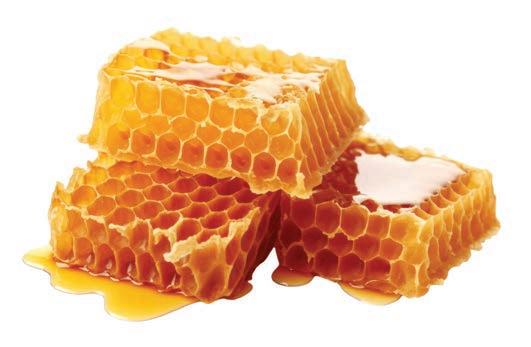

Taking care of our skin does not have to involve a complicated daily routine. “A lot of people stress out because they’re not sure if they’re using the right product or doing the right things; half the recommendations on social media conflict with each other,” says Williams. Instead of dwelling on product choices, she suggests that people find what works best for their skin and incorporate it into their daily routine, so that it becomes a constant, like other regular self-care activities.
“If you want to keep it simple in the summer, find one solid, hardworking bar that does it all: shampoo, body wash and exfoliant,” says Sloan. “Your summer skin protection routine should be focused on feeling clean, refreshed and nourished, without the fuss.”
Megy Karydes is a Chicago-based writer and author of 50 Ways to More Calm, Less Stress.
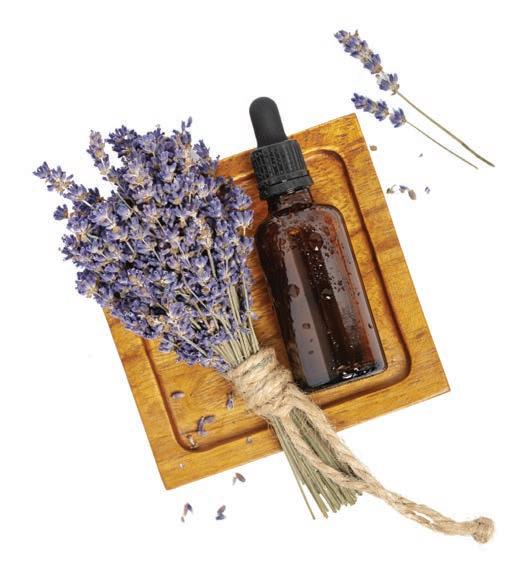

by Marlaina Donato
According to the U.S. Department of Agriculture, approximately 85 percent of Americans aged 20 and older consume breakfast daily, with eggs being a common component. Eating protein during the first meal of the day can help us feel full longer, balance blood sugar levels and potentially alleviate chronic anxiety. In addition to complex carbohydrates, fiber and heathy fats, the Mayo Clinic recommends that a nutritious breakfast always include lean protein.
“Protein is the master synthesizer, essential in its role in muscle building, immune function and energy balance,” says Melissa Halas, a registered dietitian nutritionist and certified diabetes educator in California. “Including protein early in the day helps prevent the common energy dip mid-morning and keeps satiety levels high, supporting healthy metabolism and preventing overeating later.” Protein requirements increase during
periods of stress, recovery from injury or surgery, pregnancy or breastfeeding, and life stages such as childhood, adolescence and the golden years.
Typical sweet cereals favored by kids often contain a high sugar content of 12 grams per cup, which is half of the daily recommended added sugar allowance for young children, as outlined by the American Academy of Pediatrics. Replacing low-nutrient, high-carbohydrate choices like white-flour pancakes and sugary cereal with delicious, plant-based scrambles, naturally sweet or savory breakfast bowls and delectable fruit parfaits can be both simple and satisfying.
Even if our breakfast choices are already healthier, a little extra fortification can do the body good. “Many common breakfasts like oatmeal and avocado toast don’t have
enough protein, so it’s a good idea to be diligent about meeting your protein needs at breakfast. It’ll set you up for better energy, focus and satisfaction throughout the morning, plus better metabolism. The key is combining protein with fiber and healthy fats to keep you full and fueled until lunchtime,” says New York City-based Samantha Cassetty, a registered dietitian nutritionist, author of Sugar Shock and founder of Sam’s Plate, an online nutrition and wellness source.
Whether we incorporate a tablespoon of unsweetened organic almond or peanut butter into oatmeal or layer smoked salmon and cream cheese on multigrain toast, an added source of protein can provide a boost of energy and vitality.
As a single mom, Cassetty understands the challenges of transitioning kids away from sugary foods and highly processed ingredients. She suggests making smart substitutions, such as serving whole-grain frozen waffles topped with berries and protein-rich Greek yogurt or breakfast nachos with whole-grain tortilla chips instead of breakfast tacos in highly processed taco shells. For a fun breakfast parfait, she heats frozen berries until they release their juices and then mixes the warmed fruit with plain Greek or plant-based yogurt. To enhance the texture and nutritional value, she adds a spoonful of chunky nut butter, a sprinkle of nutritious seeds or low-sugar granola.
An extra-hearty breakfast can be as simple


as adding a scoop of whey or plant-based protein powder into a whole-grain waffle mix or blending grass-fed gelatin powder into a smoothie. Protein-rich tofu, which is virtually tasteless when unseasoned, not only absorbs any flavors added to it, but also transforms into a luscious pudding when blended with a dash of plant-based milk, cinnamon and dates.
For Halas, tofu scrambled in a pan as an egg substitute and served on a whole-grain tortilla with turmeric and vegetables offers a well-balanced combination of protein and carbohydrates. She also recommends multipurpose cottage cheese, a favorite of generations past, for breakfast bowls mixed with berries, flaxseeds and walnuts, or spread onto toast with avocado. Full- or reduced-fat ricotta can provide a healthy alternative, as well.
Nutrient-dense pseudo-grains like quinoa and amaranth offer versatility. “Quinoa is traditionally eaten for breakfast in countries such as Peru as a warm porridge known as pesque,” explains Halas. “You can cook quinoa or amaranth in cow or plant milk and top it with fruit, seeds and cinnamon for a

warm cereal bowl particularly well-suited for vegetarian, gluten-free and anti-inflammatory diets, making it an excellent alternative to conventional grains at breakfast.”
Cassetty offers a savory variation, saying, “You can use quinoa to make a breakfast grain bowl with sautéed spinach, eggs and a seasoning like pesto.” She also encourages using dinner leftovers for morning nourishment.
Most of all, breakfast should feel doable. “I recommend making breakfast nourishing, satisfying and practical—something you can prep ahead of time or whip up fast,” advises Halas.
Marlaina Donato is an author and artist. Connect at WildflowersAndWoodSmoke.com.
YIELD: 2 SERVING
1 Tbsp olive oil
1 Tbsp ghee, butter or vegan butter, unsalted
1 block firm tofu
¼ tsp smoked paprika
1 dash turmeric powder
Smoked salt to taste
2 Tbsp fresh salsa
2 Tbsp fresh guacamole
Drain water from tofu and pat dry, then crumble it by hand or smash it with a fork or potato masher.
Warm the olive oil and ghee or butter in a pan over high heat until melted. Add the crumbled tofu to the pan, moving it quickly from side to side with a spatula for about 2 minutes until it resembles the consistency of scrambled eggs.
Reduce the heat to medium and add smoked paprika and turmeric. Stir until spices are well distributed and the color is even throughout the scramble.
Serve immediately with a sprinkle of smoked salt. Add fresh salsa and guacamole, if desired, on the side or spooned over the scramble.
Recipe courtesy of Marlaina Donato.
by Carrie Jackson
Cycling is more about the journey than the destination. Bikes are constantly evolving, offering more streamlined rides to engage cyclists of all ability levels. Recent trends include the rise of gravel bikes and electric bikes, advancements in tubeless tires and the increasing integration of technology. For riders that want to explore challenging terrain or upgrade their daily commute, there are numerous options for safer and more connected bikes that offer an enjoyable experience.
Multi-surface gravel bikes are built to explore unpaved roads, striking a balance between the lightweight feel of road bikes and the offroad capability of mountain bikes. Gretchen Brauer, general manager of Wheel & Sprocket, a cycling outfitter in Evanston, Illinois,

attributes the growing popularity of gravel bikes to their enhanced versatility, increased safety and superior comfort on rough terrain.
“Gravel bikes can be ridden almost anywhere—on and off-road,” she explains. “The key features are slacker geometries, a longer wheelbase and higher stack heights, which increase the comfort factor and provide better visibility. Wider road tires enable riders to navigate over all sorts of surfaces.”
Andrew Dutton, director of brand marketing at Trek Bicycle, asserts that gravel bikes open a world of adventure that is tough to find on congested roads. “Gravel bikes give riders the freedom to discover scenic, low-traffic routes with more confidence, comfort and fun,” he says. Design innovations have made it easier than ever to venture further and discover more. “Modern gravel bikes feature increased clearance for wider tires that offer better grip, more stability and more speed,” Dutton points out. “Integrated storage on models like Trek’s Checkpoint make gravel bikes perfect for everything from one-day races to multi-day escapes.”
Electric bicycles employ an electrified drive system that augments the rider’s pedaling power. The motor and battery assist in propulsion. Most e-bikes are equipped with a remote or controller to enable adjustments to the power output. The latest generation features integrated, removable batteries and varied mid-drives that position the motor at the center of the bike frame, making them user-friendly, practical and enjoyable to ride.
In recent years, e-bikes have soared in popularity, in part because they accommodate riders of all ages and fitness levels. “E-bikes allow people to ride farther distances and arrive at their destinations more quickly and less sweaty,” Brauer attests. “Some people maybe wouldn’t be able to ride without the assistance of the motors. With the options of cargo e-bikes, lots of people are able to replace their cars.”

Tubeless tire systems have gained increasing traction for a compelling reason. Frequently found on mid-range to high-end mountain bikes, as well as on gravel and road bikes, they offer improved ride quality and tire construction. “Tubeless tires do not require the use of an inner tube,” Brauer remarks. “Instead, a few ounces of sealant are put into the tire. Small punctures become instantly sealed, and the ride can continue. When riding, there are a few benefits that include decreased rolling resistance and a lower tire pressure that reduces the risk of a pinch flat.”
Brauer also notes that most bikes are now equipped with wider tires, which contribute to a more comfortable ride without compromising on speed. Disc brakes, which stop the bike by squeezing a brake pad against a rotor mounted around the hub, have become standard on nearly all categories of bikes, providing superior stopping performance in all sorts of conditions.
To enhance the riding experience and foster connections among cyclists, riders are actively seeking innovative solutions. “Technology is linking one rider to another, allowing for near constant communication among cyclists who are not actually riding together,” says Brauer. “A handful
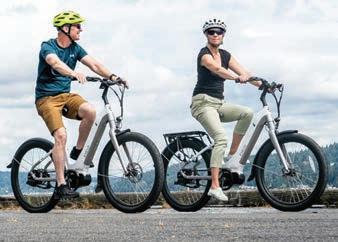
of applications track your rides. After the ride is completed, these apps allow riders to compare and compete for digital awards. You can see where and how fast your friends rode and get ideas for routes. It brings a sense of community to groups of people who wouldn’t otherwise be able to connect.”
Dutton notes that technology is making cycling safer. “Recent innovations are helping more people feel confident on the bike and excited to ride,” he shares. “Daytime running lights use a specific flash,
focus and range to help riders stand out to drivers more than a mile away, even in broad daylight. Rear-facing radar helps riders stay aware of approaching traffic while making them more visible to others on the road. Digital bells with Bluetooth speakers and advanced sound engineering help riders be heard, not just seen, even in congested areas. Together, these technologies help create a safer, more connected and more confident riding experience wherever the road (or trail) leads.”
Carrie Jackson is a Chicago-based freelance writer. Connect at CarrieJacksonWrites.com.

Spiritual Development Classes and Intuitive Workshops
Private Healing and Psychic Reading Sessions
Psychic Development and Reiki Classes (including CEs for Massage Therapists)
Guided Meditations for Intention and Clarity
Amazing Gifts and One-of-a-Kind Treasures
11108 N. Frank Lloyd Wright Blvd., Suite #E-16, Scottsdale, AZ 85259 (732) 832-1036





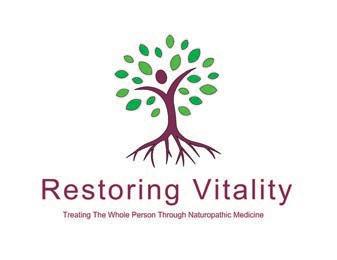
by Christina Connors
Children are naturally curious. They ask questions, dig in dirt and chase butterflies—not because they have to, but because they are wired to explore. The outdoors acts as a rich learning environment, brimming with sensory experiences, challenges and discoveries. Numerous studies corroborate what many parents and educators already sense: Outdoor play is vital to a child’s physical, cognitive and emotional development.
“The simple act of walking barefoot on the earth, feeling the breeze or placing hands
in the soil anchors children in the present moment, calming racing thoughts and settling restless bodies,” says Tara Beall-Gomes, a therapist, certified school counselor and founder of Main Street Counseling, in Connecticut.
A 2019 study published in Frontiers in Psychology reported that children that spent more time in nature displayed improved executive functioning, which encompasses essential skills such as planning, decision-making and problem-solving. The researchers observed that even brief periods

of unstructured outdoor play significantly boosted working memory and attention spans in young children.
“What I have found in my own life is that Mother Nature nurtures and heals,” says Terry Murphy, founder of The Healing Chickadee, a grief program for children. “The energy of the trees, flowers, shrubs and grass feeds our souls. My grandkids crave the outdoors, and it brings about a sense of wonder and a deep serenity.”
According to the Children & Nature Network, a comprehensive review of multiple studies revealed that spending time outdoors reduces stress hormones such as cortisol in children. A compelling 2011 study from the University of Illinois demonstrated that children with attention-deficit/hyperactivity disorder (ADHD) that played in open, natural settings exhibited improved focus and reduced hyperactivity compared to those playing indoors or in less green environments.
“The outdoors is nature’s original healing space. One of my favorite things to talk about, especially for kids with ADHD, is how being outside naturally boosts dopamine,” says Beall-Gomes. “Dopamine is the brain’s ‘feel-good’ chemical that helps with motivation, focus and mood regulation—all areas that can be extra challenging for kids with ADHD.”
Nature offers a multitude of joys, adventures and therapeutic benefits. Here are some ways to enjoy the outdoors with the whole family.
Outdoor Exercise: According to BeallGomes, “Activities like running, climbing, biking or even just digging in the dirt get the body moving and help increase dopamine levels in a natural, healthy way. Plus, the unstructured playtime kids get outdoors gives their brains a much-needed break from screens and structured demands, helping them reset and recharge.”
Connecting With Birds: “Focusing on birds, getting quiet and listening to them singing is

a great metaphor for joy and resilience,” states Murphy. “A small bird is able to handle very harsh winters and still have a song to sing. This is something we want to teach our kids. Remind them that even though they are small, they can still get through hard things and find joy.”
Scavenger Hunts: A scavenger hunt is an easy, customizable method to engage kids with the natural environment. Whether in a city park or in the woods, these hunts transform every leaf and stone into an integral component of an exciting game. They provide children with the opportunity to practice and develop a number of life skills. By looking closer at objects and asking questions, they hone their curiosity. Collaborating with siblings or friends teaches them cooperation, teamwork and effective communication. And, analyzing clues sharpens their critical thinking and problem-solving abilities.
Mindful Activities: “You don’t need elaborate plans to benefit from nature. Some of the most meaningful moments come from simple, mindful activities,” explains Beall-Gomes. “One of my favorite suggestions is taking a mindful walk with a child, intentionally engaging all five senses. If you can’t go for a walk, open a window and just be present. Listen to the rustling leaves or birdsong; notice the colors and patterns around you; feel the texture of tree bark, the grass under your fingers or the rain on your skin; breathe in the earthy or floral scents; and if safe, maybe even taste a ripe berry or fresh herb from a garden.”
Community Gardens: “Community gardens are another beautiful space for children to connect not just with nature but with others, offering shared purpose, cooperation and the joy of seeing something grow,” says Beall-Gomes. “Beyond the hands-on experience, gardens help kids practice social thinking skills like sharing space, collaborating, waiting their turn and thinking about how their actions affect the group. These kinds of activities help anchor children in the present moment, reduce stress and build emotional and social resilience, all while having fun outdoors.”
Christina Connors is a writer, singer and creator of a YouTube series for children. Learn more at ChristinaConnors.com.

by Ruth Roberts, DVM, CVA, CVH, CVFT, NAN
Arthritis and joint pain cause even the most energetic dogs to slow down. While medications and physical therapy are common treatments, addressing the dog’s digestive system may be the missing link to restoring mobility and comfort.
Inflammation in dogs is commonly associated with injuries or autoimmune diseases such as immune-mediated polyarthritis. However, chronic inflammation can also originate in the gut. The digestive tract hosts trillions of microorganisms that influence the immune response. When the gut lining is damaged or the microbiome is disrupted, substances may leak into the bloodstream, triggering systemic inflammation that can affect organs and joints.
“As a holistic pet health coach, I’ve seen time and again how joint pain and mobility issues improve when the gut is healed,” says Melissa Knievel Natanson, a holistic pet health coach and canine nutritionist in Pismo Beach, California. “Chronic gut inflammation, dysbiosis or leaky gut can trigger systemic inflammation, which often presents as joint pain. Many dogs with arthritis also have a history of gastrointestinal issues like loose stools, skin flareups or food sensitivities. These could be important clues of a gut-joint connection.”
A 2020 study published in Veterinary Sciences supports this link, revealing notable
differences in the gut bacteria of arthritic and healthy dogs. Arthritic dogs had lower levels of microbial families that were more abundant in healthy dogs, including Paraprevotellaceae, Porphyromonadaceae and Mogibacteriaceae. These bacteria are often associated with a strong gut lining and balanced immune function. The arthritic dogs had higher levels of anti-inflammatory bacteria like Megamonas
Natanson notes that the gut and joints are closely connected through the immune system, and shifts in the microbiome may influence how the dog’s body manages inflammation and responds to joint stress.
Omega-3 fatty acids, which are rich in eicosapentaenoic acid (EPA) and docosahexaenoic acid (DHA), may help support joint health and mobility in dogs. A 2010 multi-center clinical study of 127 dogs with osteoarthritis published in the Journal of the American Veterinary Medical Association found that dogs that consumed higher levels of omega-3 fatty acids and lower levels of omega-6 fatty acids exhibited significantly elevated blood levels of EPA and DHA. They also demonstrated improvements in mobility compared to dogs receiving commercial food. Pet owners of the dogs on the test diet reported that their canine companions had an easier time standing

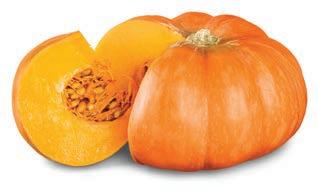
up, walking and playing within weeks of starting the dietary regimen.
Natanson recommends incorporating omega-3 fatty acids into a balanced and speciesappropriate canine diet to mitigate inflammation. She emphasizes the consumption of fresh foods that are naturally anti-inflammatory such as fatty fish, bone broth, turmeric, fermented vegetables and antioxidant-rich fruits like blueberries. She also advises against the consumption of ultra-processed kibble, grains and synthetic additives.
Additionally, Natanson recommends manganese-rich foods to support the health of joints and connective tissues because it plays a key role in the formation of collagen, cartilage and joint fluid. Many older dogs are deficient—especially those fed processed diets. Whole-food sources such as green-lipped mussels, pumpkin seeds and blueberries can help replenish this important mineral.
Natanson highlights pumpkin as a gentle, gut-friendly food option. Not only does it provide prebiotic fiber to nourish healthy gut flora, but it also delivers a natural dose of manganese, making it a smart addition for dogs with digestive and joint concerns.
It is important to introduce these anti-inflammatory foods with caution, particularly for dogs with sensitive digestive systems. Natanson warns that while turmeric is a powerful anti-inflammatory, it can cause loose stools in dogs with a leaky gut or active gastrointestinal inflammation. Similarly, sweet potatoes, often seen as anti-inflammatory, may not be suitable for dogs with gut dysbiosis, yeast overgrowth or metabolic imbalances due to their high starch and sugar content. Natanson says the same can be said for high-fat fish oils that provide excellent joint support but may aggravate pancreatitis or bile-related issues when introduced too aggressively.


Because inflammation can originate in the gut, managing arthritis should involve a comprehensive approach that extends beyond joint-focused solutions. Avoiding processed foods, reducing synthetic additives and prioritizing nutrient-dense meals may help reduce overall inflammation and support long-term wellness.
For pet parents grappling with chronic health concerns like arthritis, Natanson encourages taking one step at a time, advising, “Start with gut health. You don’t need 20 supplements—just focus on whole foods, trust the process and pay attention to your dog’s cues. Simple, consistent changes can have profound results.” A holistic veterinarian or pet health coach can assist pet parents by customizing a diet plan based on their dog’s individual condition and tolerance.
Learn more about Dr. Ruth Roberts’ approach to holistic pet care and wellness at DrRuthRoberts.com.



by Maya Whitman
The world’s agriculture is largely reliant on the cultivation of single crops upon sizable tracts of land for staples like wheat, corn, soybeans and rice. Known as monoculture, this approach offers efficiency and low-cost produce, but it also carries significant ecological consequences, including the depletion of soil nutrients, ground pollution, increased carbon emissions, water scarcity, crop failures and the loss of pollinators due to degraded ecosystems.
One promising sustainable alternative is the development of decentralized food forests in small, local settings like rural backyards, urban parks, roadsides and vacant
lots. Based on agroforestry—the practice of integrating trees and shrubs with diverse crops—food forests simulate the verticality of a forest while creating highly diverse ecosystems comprised of tiers of edible plants.
According to Science Mill, a Texas-based nonprofit that promotes scientific exploration and education, the ideal food forest is comprised of multiple layers, including a canopy of large fruit and nut trees, an understory of dwarf fruit trees, shrubs such as blueberries or currants, perennials and herbaceous plants, ground cover plants like creeping thyme, root crops and climbing vines.

These regenerative, edible landscapes replenish themselves, eliminating the need for annual replanting. Harmonious crops work as a symphonic whole, naturally repelling pests and fortifying the soil. The resulting benefits include water conservation, carbon sequestration, biodiversity, thriving pollinator populations, bolstered local economies and a reduction of food transportation costs.
“By creating a regenerative edible garden in whatever space you have available, you are creating habitats and food for the preservation of nature that allows all life—wild and tamed, present and future—to thrive. No plot of land is too small to start a magic garden,” says Maria Rodale, a master gardener and board member of Rodale Institute, as well as the author of several books, including Organic Manifesto. “For me, it’s not regenerative unless it’s organic, and it’s especially regenerative if we are gardening with and for nature, rather than just for ourselves.”
ChrisCafferkey from Getty Images/CanvaPro
The first step in planning an edible paradise is consulting a resource such as the U.S. Department of Agriculture Plant Hardiness Zone Map (PlantHardiness.ars.usda.gov) to determine which plants thrive in the local climate zone. Choosing native, foodbearing plants and using organic mulch year-round will enhance the garden’s resilience against extreme weather conditions, and annual rotation of plant families will help prevent disease. In urban or small areas, vertical gardening, which is most easily achieved by adding trellises to raised beds, will maximize the available space for additional plants.
“It’s absolutely not necessary to own a lot of land to create a food forest,” says Rodale, noting that edibles can be grown in pots on windowsills, in the front or back yard, and even on rooftops. She recommends planting an understory of edible berries, as well as herbs and vegetable crops at the ground level. Root vegetables such as purple sweet potatoes “make a beautiful ground cover, and the

leaves are even more delicious than spinach. Other roots like horseradish make beautiful and productive landscape plants,” she explains.
According to New Jersey horticulturist and certified arborist Melinda Myers, “Containers are great options for everyone. You can increase growing space and keep the plants handy for easy planting, care and harvesting. I like to invite my guests to pick their own salad ingredients, herbs for seasoning or fresh tomatoes for snacking from containers on my patio.”
Myers, an instructor in The Great Courses series How to Grow Anything and the author of several gardening books, incorporates edible plants with flowers in her garden beds and containers. “‘Bright Lights’ Swiss chard has colorful stems and makes a nice vertical accent in containers. It combines nicely with pansies and colorful lettuce in the spring and fall,” she says. “I love to grow asparagus at the back of my perennial gardens. I harvest the spears in spring, and once the greenery appears to replenish the plant’s energy, I have a nice, ferny backdrop for the flowers.”
Sharing a garden surplus with neighbors, senior centers and other organizations that need nutritious produce can have a far-reaching positive impact. Collaborating with fellow gardeners to swap helpful hacks or share garden chores can also be a blessing. “People are so busy these days that working with others provides lots of benefits,” says Myers, praising the round-robin approach “where you help each other tend your gardens, share food and drink and have some time to socialize.”
Creating a food forest aims to foster a thriving ecosystem and a sense of community that extends to nature. “Let the weeds be part of your garden,” exclaims Rodale. “Many common weeds are habitats for the bugs that feed birds and are edible and medicinal. I noticed that groundhogs and rabbits preferred the weeds to my vegetables when I stopped weeding so heavily.”
Maya Whitman is a regular contributor to Natural Awakenings.


Find your best-matched vetted holistic and whole health providers Join as a KnoWEwell Regenerative Whole Health member
AND WELL-BEING
VETTED PRACTITIONERS
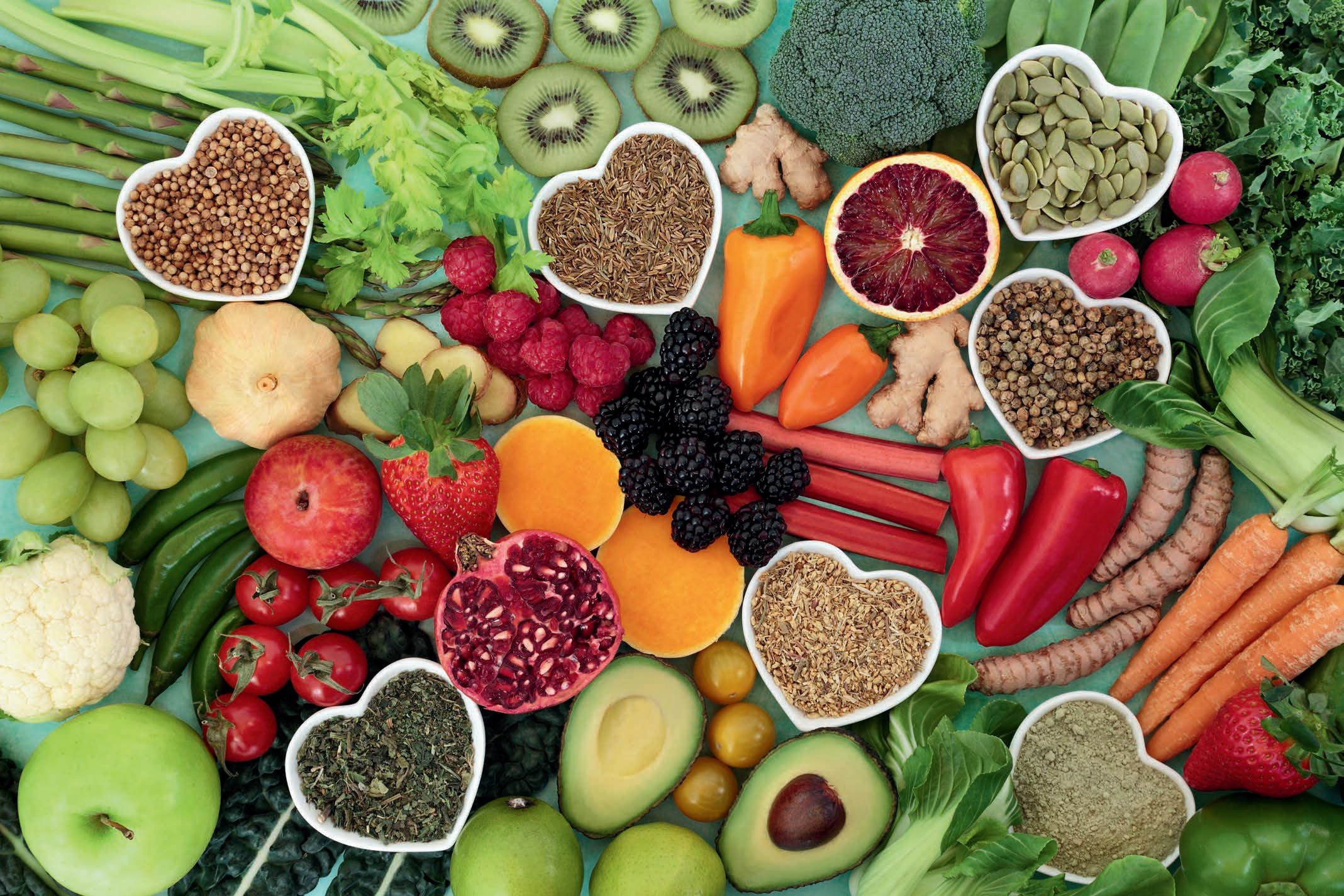
WEBCASTS
700+ and Growing ive and On-Demand Expert Webcasts
EDUCATIONAL SHOWS
Curate your own library of 160+ and Growing Whole Health Expert hows
COMMUNITIES
Make meaningful connections in 200+ and growing Whole Health & Expert Communities
DISCOUNTS
Get discounts on expert healing programs and courses
Awakenings readers receive a 30% discount on KnoWEwell memberships. Join at: nowewell.com/ communi /join-individuals




Make a meaningful impact in your community by becoming the owner of a Natural Awakenings magazine. Empower others with current, valuable insights and resources to enhance their physical, mental, emotional and spiritual well-being.
As a franchise owner, you’ll inspire positive change, provide readers with tools for healthier living and connect local businesses with an audience eager for transformation.
Why Own a Natural Awakenings Magazine?

n Create a Healthier Community: Be the go-to resource for wellness and personal growth in your area.
n Boost Your Income: Take control of your financial future with a proven business model.
n Enjoy a Flexible Lifestyle: Work from home while pursuing a fulfilling, dynamic career.
n A proven business model with low startup costs.
n Comprehensive training and friendly, ongoing support.
n Flexible work schedule with many work-from-home opportunities.
n Access to a network of like-minded franchise owners.
n Financing Options Available.
Join a thriving network of passionate franchise owners reshaping the future of holistic health and wellness.
Call 239-206-2000 for a FREE evaluation of your community’s potential. Learn more or apply today at: Corp.NaturalAwakenings.com

or learn more, visit Corp.NaturalAwakenings.com.
Add Your Community to Where Natural Awakenings Is Now Publishing:
• Atlanta, GA
• Boston, MA
• Broward County, FL
• Bucks/Montgomery Counties, PA
• Central Florida/Greater Orlando, FL
• Central New Jersey
• Charlotte, NC
• Chicago, IL
• Columbia, SC
• Dallas, TX
• Daytona/Volusia/Flagler Counties, FL
• Detroit/Wayne County, MI
• Fairfield & Southern Litchfield Counties, CT
• Gainesville/Ocala/The Villages, FL
• Grand Traverse Region/Northern Michigan
• Greater Ann Arbor, MI
• Greater Lansing, MI
• Greater Oakland, Macomb, Livingston, Genesee, MI
• Gulf Coast, Alabama/Mississippi
• Hartford/Tolland, CT - Coming soon
• Houston, TX
• Hudson County, NJ
• Jacksonville/St. Augustine, FL
• Lancaster/Berks, PA
• Lehigh Valley, PA
• Long Island, NY
• Milwaukee, WI
• Monmouth/Ocean Counties, NJ
• Naples/Fort Myers, FL
• New Haven, CT
• New London/Windham, CT - Coming soon
• New York City, NY
• North Central New Jersey
• North New Jersey
• Northwest Florida
• Palm Beach, FL
• Philadelphia, PA
• Phoenix, AZ
• Pittsburgh, PA
• Rhode Island
• Richmond, VA
• Sarasota, Manatee, Charlotte and DeSoto Counties, FL
• South Central Pennsylvania
• South Jersey, NJ
• Southeast North Carolina
• Space & Treasure Coast, FL
• Tampa, FL
• Tucson, AZ
• Twin Cities, MN
• Westchester/Putnam/Dutchess, NY
• Western Michigan

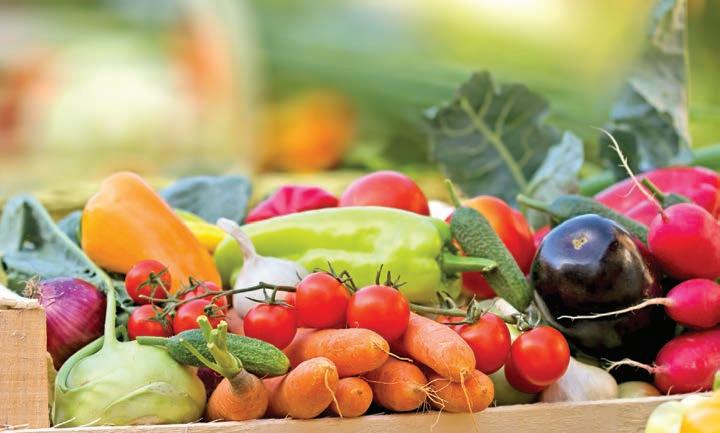
NOTE: Please check market websites and ArizonaCommunityFarmersMarkets.com for more information on days and hours, and any restrictions.
Ahwatukee Farmers Market
4700 E Warner Rd, Phoenix
Sundays Oct-May 9am-1pm Jun-Sep 8am-11am
Facebook.com/AhwatukeeFarmersMarket
Carefree Farmers Market
1 Sundial Circle
Fridays Oct-May 9am-1pm Jun-Sep 8am-11am
Facebook.com/CarefreeFarmersMarket
Downtown Chandler Farmers Market
3 S Arizona Ave
Saturdays Oct-May 9am-1pm Jun-Sep 7am-10am
DowntownChandler.org/events/farmers-market
Downtown Mesa Farmers Market
1 E Main St
Saturdays 8am-noon dtMesaFarmersMarket.com
Downtown Phoenix Farmers Market 720 N 5th Street
Saturdays Oct-May 8am-1pm
May-Oct 7:30am-11:30am DowntownPhoenixFarmersMarket.org
Gilbert Farmers Market
222 N Ash St
Saturdays Oct-Apr 8am-noon May-Sep 7-11am GilbertMarket.com
High Street Farmers Market
5415 E High St, Phoenix
Sundays Oct-May 9am-1pm
Facebook.com/Farmers-Market-on-HighStreet-2244771575799425
Mommas Organic Market
Arrowhead Farmers Market
7780 W Arrowhead Towne Center, Glendale
Saturdays Oct-Apr 9am-1pm | May-Sep 8-11am
Facebook.com/Getlocalazfarmersmarkets GetLocalArizonaEvents.com
Mommas Organic Market
Glendale Farmers Market at Cabela’s 9380 W Glendale Ave, Glendale
Sundays Sep-May 10am-2pm | closed for summer Facebook.com/Getlocalazfarmersmarkets GetLocalArizonaEvents.com
Ocotillo Farmers Market
2577 W Queen Creek Rd, Chandler
Sundays Oct-May 9am-1pm ArizonaCommunityFarmersMarkets.com/ ocotillo-farmers-market
Old Town Scottsdale Farmers Market
3806 N Brown Ave
Saturdays Oct-Apr 8am-noon, May-Jun 7-10am
Facebook.com/OldTownScottsdaleFarmersMarket
Power Road Farmers Market
4011 S Power Rd, Mesa
Monday-Saturday 9am-5pm | Sunday 9am-4pm PowerrdFarmersMarket.com
Roadrunner Park Farmers Market
3502 E Cactus Rd, Phoenix
Saturdays Oct-May 8am-noon | Jun-Sep 7-10am
Facebook.com/RoadrunnerParkFarmersMarket



Singh Meadows Farmers Market 1490 E Weber Dr
Fridays, Saturdays & Sundays 8am-2pm
Facebook.com/SinghFarms
Sun City Farmers Market 16820 N 99th Ave
Thursdays Oct-May 9am-1pm Facebook.com/Sun-City-Farmers-Market631299790224049
Uptown Farmers Market 5757 N Central Ave, Phoenix Wednesdays Oct-Apr 9am-1pm & May-Jun 8am-noon
Saturdays Nov-Apr 8am-1pm & May-Oct 8am-noon
UptownMarketAZ.com
Verrado Community Farmers Market N Market Pl & W Main St, Buckeye Sundays Oct-Jun 9am-1pm Facebook.com/VerradoCommunityFarmersMarket
Farmers Market in Old Town Square 1042 N Main St, Cottonwood Wednesdays 3-7pm (check months/times throughout year)
Facebook.com/FarmersMarketatOldTownSquare
Flagstaff Community Farmers Market 211 W Aspen Ave, City Hall Parking Lot Sundays May-Oct 9am-1pm FlagstaffMarket.com
Prescott Farmers Market
Dignity Health, YRMC 900 Iron Springs Rd, Miller Valley Lot Saturdays Nov-Mar 9:30am-12:30pm Apr-Oct 7:30am-noon PrescottFarmersMarket.org
Sedona Community Farmers Market
Wells Fargo Bank Parking Lot 2201 W State Rte 89A, West Sedona Sundays May-Oct 8am-noon Nov-Apr 11am-3pm Sedona-Farmers-Market.com
Verde Valley Farmers Market Hollamon St and Main St, Camp Verde Saturdays May-Oct 8-11am Facebook.com/VerdeValleyFarmersMarket
Windmill Park Farmers Market
9950 E Cornville Rd, Cornville Thursdays 2-6pm (check months/times throughout year)
Facebook.com/WindmillParkFarmersMarket



Connecting you to the leaders in natural health care and green living in our community. To find out how you can be included in the Business Directory, email PhoenixAds@NaturalAZ.com to request our media kit.
ARIZONA LEECH THERAPY
c Gershkovich, CHP, CRP, PMP, Therapist 8765 E Bell Rd, Ste 110, Scottsdale 480-621-6041 • ArizonaLeechTherapy.com ArizonaLeechTherapy@gmail.com

Pavel Gershkovich, owner of Arizona Leech Therapy, is a professional medicinal leech therapist. He is here to help you find a natural, drug-free solution for your medical conditions, such as cardiovascular, high blood pressure, migraine, urology/ prostate, varicose veins, and deep venous thrombosis. See ad, page 23.
LEADING EDGE WELLNESS
MacKenzie Kalt, Owner/Director 4050 E Greenway Rd, Ste 5, Phoenix 480-594-5052 • MyLeadingEdgeWellness.com

Providing some of the most advanced natural technologies for those struggling with chronic pain, injuries, stress, migraine headaches, PTSD, insomnia, Lyme disease, autoimmune disorders, skin conditions, and much more. Visit our website to learn more. See ad, inside front cover.
NATURAL MEDICINE & DETOX
2701 N 7th St, Phoenix 602-307-0888 • NaturalMedicineDetox.com

We offer a wide range of services that can help just about everyone at affordable prices. We also accept insurance for acupuncture, including Medicare. Please take a look at our website to learn about our services, gifted practitioners, and insurance information and form to see if your plan covers acupuncture. See ad, page 17.
NAMASTE BOOKKEEPING
Jen & Mark Arnold 480-442-8208
JandM@NamasteBookkeeping.com

You are passionate about the work you do! It’s not a job; it’s a mission, a calling, a ministry. And it lights you up! There is nothing you would rather be doing. You make a difference! Let us help you so you can help the world!
ALLY SPINE CENTER
10565 N 114th St, Ste 109, Scottsdale 480-809-4700 • asc.drc2000@gmail.com AllySpineCenter.com

Dr. Chris Condon utilizes stateof-the-art techniques and technologies including non-surgical spinal decompression with the SpineMed and SUMMUS class 4 medical laser for the correction of degenerative spinal conditions including stenosis, herniated/bulging discs and neuropathy as well as knee decompression with the Knee On Trac.
NATURAL DENTAL PARTNERS
6930 E Chauncey Ln, Ste 100, Phoenix 602-775-5120 • MyNaturalDentist.com



The doctors at Natural Dental Partners take the time to listen to your concerns and use their extensive experience to help you achieve better health. Using the latest technology (such as low-dose 3D imaging, CEREC, lasers, PRF, ozone and treatment of sleep disorders), they believe in a team approach to help you achieve your healthcare goals. Check out MyNaturalDentist.com or ABreathOfHealth. com to see how they can help you. See ad, page 3.

Dr. Josh Raiffe, DMD, AIAOMT 11111 N Scottsdale Rd, Ste 120, Scottsdale 480-998-3923 • SheaDentalAZ.com

Shea Dental offers holistic dentistry led by Dr. Josh Raiffe, DMD, AIAOMT Accredited. Using advanced technology like CEREC milling, digital impressions, Wand anesthesia, cone beam CT scanning, and SMART mercury filling removal, Dr. Raiffe ensures safe dental practices. Services include implants, veneers and sleep apnea treatments. Accepts most dental insurance. See ad, page 5.
SACRED LIGHT OF COSMIC AWARENESS COMMUNITY 480-273-4577 • SacredLight777@proton.me SacredLightCommunity.com

Reclaim your power. Identify your soul purpose. Spiritual healing an d self-realization workshops. Channeled messages from the Divine Creator. Free PastLife Readings. Develop psychic clarity, inner trust, strength and confidence; examine hidden unconscious patterns; and engage in personal power management, karmic healing, calming the mind and dream interpretation.
OSTEOSTRONG
8120 N Hayden Rd, Scottsdale Text/call 602-932-2792 OsteoStrongScottsdale.com

OsteoStrong is a leader in natural bone health and wellness with centers in Phoenix (Arcadia) and Scottsdale (McCormick Ranch). Our m embers report significant improvements in osteoporosis, physical strength, balance and posture in 15 minutes a week. Specializing in osteogenesis without drugs, we’re dedicated to holistically enhancing quality of life. See ad, page 4.
PRECISION BONE IMAGING
Locations in Phoenix and Scottsdale 888-415-7377
PrecisionBoneImaging.com

Precision Bone Imaging is the #1 Echolight REMS provider in the U.S., offering a more accurate, radiationfree alternative to DXA for bone density and quality assessments. REMS technology delivers a comprehensive assessment, helping you prevent osteoporosis or monitor your bone health baseline with confidence.
RESTORING VITALITY CLINIC
Paw Kamwee, NMD 34470 S Old Black Canyon Hwy Black Canyon City
623-374-9498 • Restoring-Vitality.com

At Restoring Vitality, we blend the best of modern science with time-honored natural healing techniques to provide a comprehensive and integrative approach to your wellness. We believe in empowering our patients to take control of their health, and we are committed to providing the guidance and support you need to achieve your wellness goals. See ad, page 21.
ANDREA BRIGGS, AKA “CRITTER DOC”
ASAM, Sh Reiki, HTAP Communicator, Healer, Counselor 602-317-1543 • 1CritterDoc@gmail.com SpiritAnimalWisdom.com

With a gentle healing touch, Andrea provides wellness counseling, energy healing, animal communication, and intuitive counsel for pets and their people.
HEALING ARTS
1538 E Southern Ave, Tempe 480-994-9244
Info@swiha.edu • swiha.edu

Nationally accredited college offers holistic health and wellness degrees, diplomas, certificates of excellence, continuing education and personal development, oncampus and online. Financial aid available. See ad, outside back cover.
OF
11108 N Frank Lloyd Wright Blvd, Ste E16 Scottsdale • 732-832-1036
DimensionsOfHeavenAndEarth.com

Dimensions of Heaven and Earth is Scottsdale’s exciting, new one-stop Spiritual Experience: a center of healing and insight combined with a store full of unique gifts from local artisans. With training and tools for your personal development, we are excited to help you take your spiritual journey to new levels! See ad, page 21.
The Path of Spiritual Freedom 1-877-300-4949 • EckankarArizona.org Eckankar.org • HearHU.org Facebook.com/EckankarArizona

Eckankar is an active, individual, creative spiritual practice. A companion and roadmap for your journey home—to the heights of Self-Discovery and GodDiscovery, and beyond. Come along and discover the most secret part of yourself. The key to spiritual freedom lies within you. Explore life as a Soul Adventure. See ad, page 25.








